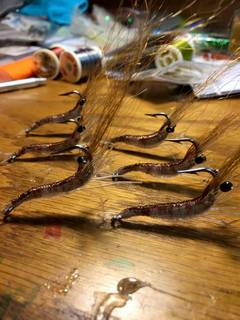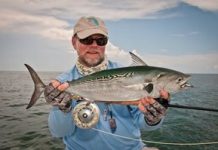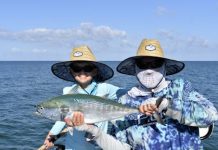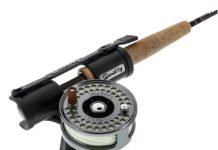By CAPT. PAT DAMICO, CapMel.com Fly Fishing Editor
Rods used to cast flies have been made of many types of material. Lancewood, Greenheart, Ash and Basswood each went thru a period when they were thought to be the ideal material for rod assembly. Before and after that, bamboo was used in Asia, Europe and in the mid 1800’s found its way to America. Several builders here used split bamboo to build complete rods in the 1860’s. Tonkin bamboo wasn’t discovered as a rod making material until the 1930’s. Today there are some very skilled craftsmen who still choose to use bamboo to build fly rods. They sometime refer to the composite space age materials we commonly use for our modern rods as, “plastic.” Why has bamboo endured?
I hadn’t used a bamboo rod in many years, having first used a three piece relic that some relative gave me when I was a teenager that had been broken several times. About ten years ago I was visiting a sporting goods and saw a used bamboo rod on the shelf. It needed some work, so my forty dollar investment seemed reasonable. I replaced the reel seat and fixed a couple guides and started to fish with it. Small trout streams, a double taper four weight fly line and some tiny terrestrials made me feel like some of the fly fishing legends were watching me. Short accurate casts were needed. I had to slow everything down a little to cast better, but I found using bamboo very relaxing.
Last summer I was walking the beach, fly rod in hand, looking for snook, and I watched a guy stringing what looked like a bamboo fly rod. When I saw that it was, I stopped to talk to him. His grandfather, a freshwater trout fisherman, had recently passed away and left him two of his rods. He was preparing to try it in the salt. It was not a very high end rod, but I told him I would put it back in its case and reserve it for freshwater, if he wanted to use it, or keep it as a memento. Even though many of the initial saltwater fly fishing adventures for bonefish, trout and tarpon were attempted with bamboo rods, most of this was done by people who understood the need for extreme care, and maintenance. My own feelings are that bamboo is for fresh water. In Florida, a few warm water fly fishers love to use bamboo for panfish and bass.
Our Suncoast Fly Fishers club in St. Petersburg has a member, Terry Kirkpatrick, who builds bamboo fly rods. One of Terry’s, Fish Tested rods has accompanied me on many memorable trout fishing trips to some of my native Pennsylvania streams. When I take the rod out of its case, I always feel a touch of nostalgia. Terry has given clinics to both local clubs as well as at some large fly fishing conclaves. Recently I spent a couple hours with Terry as he showed me each complex step involved it the tedious process of selecting a large bamboo culm and eventually ending with a six piece delicate casting wonder.
Terry’s interest began years ago when he repaired some bamboo rods, rebuilt others and did everything but assemble a complete rod from start to finish. A lot of reading, talking with established rod builders and forum time prepared him for his first creative adventure. The reason it is called a split bamboo rod, is because the first step is to select a culm of bamboo about two inches in diameter, and with a knife split this piece and many others. Nodes are marked and two sections are selected that are very close in configuration and coded. They are staggered to distribute stress. Three pairs of strips will eventually make the six equilateral triangular tapered pieces that will be glued together to form each rod section. Heat treatment is used to straighten all pieces. They are bound and placed in a special oven at 300 degrees. All nodules are flattened to help the future planning process. A machine is used for initial reduction, and then at least four different hand planning procedures are used. An adjustable jig is set up with micrometer readings to insure accuracy. The type rod will determine how the jigs are set up to get the desired taper. Rod action can be modified by adjusting the taper slightly. When all the individual pieces are accurately planed, they are cemented together with water proof glue. A special binding machine that he made, winds string around the pieces and the assembled rod section is hung to dry. After drying, string is removed along with excess glue without damaging the sections. If needed, more straightening may be done by carefully applying heat. Nickel silver ferrules and tip guide are fitted, and cemented; other hardware is selected. Eight to ten coats of Tru oil will be applied to the bamboo, allowing each to dry thoroughly. The grip and reel seat are cemented in place. Guides are placed with tape, and the rod is bent to check their position. After adjusting guides, some casting can be done for final location before recording each guides position. Guides are wrapped with thread and several coats of spar varnish are applied to wrappings. A special drip tube is used to varnish the finished rod so that all bubbles and dust are eliminated. After forty eight hours and a final inspection, the rod is waxed and hand polished.
A finished bamboo fly rod is a work of art. Many hours of labor and love go into each step in the process. Most fly fishers who try bamboo for the first time work too hard, forcing it to perform. The rod will do the work if you give it a chance. Modern rod builders like Terry have taken an old art form and continue to refine it. Every time I asked a question, Terry would answer it several ways, giving a detailed reason for each. The next time you see a bamboo fly rod, carefully examine it and know that you are holding a piece of history that will always be with us.
Terry Kirkpatrick’s website is www.fishtested.com.
Capt. Pat Damico, an FFF certified fly casting instructor, guides in lower Tampa Bay. His website www.captpat.com, has more information about fly and light tackle charters.
- Captain’s Corner:Pat Damico - June 25, 2019
- Flat water makes seeing tarpon easier - May 17, 2017
- Warm rivers holding plenty of targets for fly fishermen - February 16, 2017











